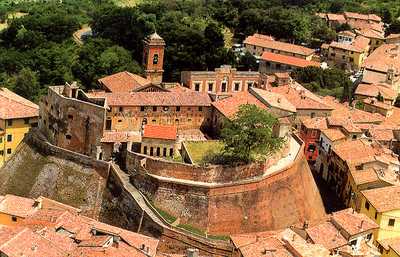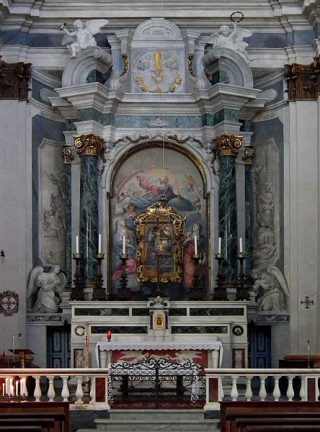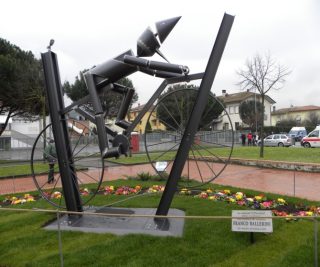GOSTANZA, THE WITCH FROM SAN MINIATO
Gostanza was a 50 year-old widow who lived in San Miniato about 500 years ago. She was a poor peasant and earned her living as a midwife.
The misadventures of this woman started in the Castle of Lari, near Pisa, in 1594, when two women and two men charged Gostanza da Libbiano with provoking several babies’ death by using witchcraft.
Gostanza was interrogated in a trial, which took place in San Miniato, and she admitted she had used ointments and placed a candle on women in labour as a symbol of good luck but she denied she had provoked newborns’ death.
The inquisitor sentenced her to the “torture of the ropes”.  After being hung by a rope which stretched her arms she admitted she had practised witchcraft upon several people.In the following days the poor woman began to confess more and more in order to avoid new tortures. She even admitted she had had a relationship with several demons and she had taken on the form of a black cat, sucked children’s blood and stolen and fried consecrate Hosts in order to offer them as a sacrifice to a demon called “Polletto”.
After being hung by a rope which stretched her arms she admitted she had practised witchcraft upon several people.In the following days the poor woman began to confess more and more in order to avoid new tortures. She even admitted she had had a relationship with several demons and she had taken on the form of a black cat, sucked children’s blood and stolen and fried consecrate Hosts in order to offer them as a sacrifice to a demon called “Polletto”.
She was going to be burnt at the stake but on 19th November 1594, Dionigi da Costacciaro, a new Florentine inquisitor, realized her confessions had been invented by a human mind and not by the devil and her confessions were just lies so he decided to keep Gostanza in prison for a few days and put an end to her torture. 
The inquisitor interrogated Gostanza on different occasions and finally on 24th November he asked her if she was willing to swear that her confessions were true.
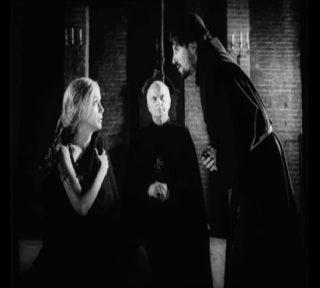
The widow explained that they were all lies and admitted she had confessed everything just in order to put an end to her torture and die.
The trial came to an end with Gostanza’s absolution and the acknowledgment of her innocence on 28th November.
The inquisitor ordered her not to use potions any longer and move to another town.
THE ORATORY OF LORETINO
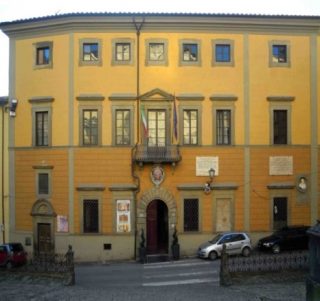 The oratory of Loretino, built inside the town Hall at the end of the 13th century as the private chapel of the governors, became a very important place of worship for the people from San Miniato in1399 when the wooden image of the holy crucifix, considered to have miraculous powers, was placed here.
The oratory of Loretino, built inside the town Hall at the end of the 13th century as the private chapel of the governors, became a very important place of worship for the people from San Miniato in1399 when the wooden image of the holy crucifix, considered to have miraculous powers, was placed here.
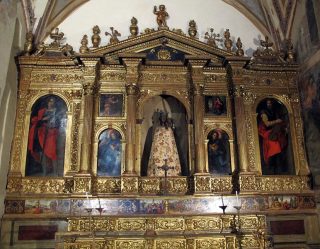 According to a Legend, the simulacrum was brought to San Miniato by two mysterious travellers, who were probably two angels. They left it in the house of a poor widow. It was closed up in a case and it emanated an “arcane” light at night. It became a symbol of peace and love.
According to a Legend, the simulacrum was brought to San Miniato by two mysterious travellers, who were probably two angels. They left it in the house of a poor widow. It was closed up in a case and it emanated an “arcane” light at night. It became a symbol of peace and love.
The veneration of the Holy Crucifix increased between 1629 and 1631 when the Bubonic Plague spread in Italy. A church was built in honour of this Holy Crucifix.
The Crucifix was placed in the Sanctuary of the Holy Crucifix in 1718 .
PIER DELLE VIGNE (1190-1249)
Pier Delle Vigne was a writer and a diplomat. He was the Secretary and Chancellor of Frederick II, Frederick Barbarossa’s grandson, and he was the King of Sicily and the Holy Roman Emperor.
According to the legend, Pier Delle Vigne was charged with treason and imprisoned in the Fort in San Miniato in 1248.
After a year in prison he was visited by the Emperor.
He was unable to communicate or defend himself so the Emperor had his eyes ripped out. Unable to bear it, he committed suicide in the Fort.
Pier delle Vigne is mentioned in the Divine Comedy by Dante Alighieri (“Inferno, Canto XIII “).
He reveals Dante and Virgil his identity saying “I am the man who held both the keys of Frederick’s heart…”. This means Frederick II trusted him a lot. This sentence is written on a stone under the Fort in San Miniato.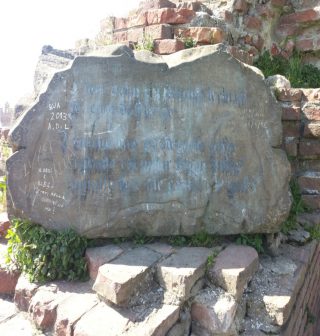
PINOCCHIO
One hundred years ago the name of San Miniato Basso was “Il Pinocchio”.
Its name came from the name of a bridge “Pidocchio” built there in the 14th century. The area near the bridge was called “Ponte al Pidocchio “because dirty pilgrims and beggars (” Pidocchiosi” means full of lice in Italian) on a pilgrimage on the Via Francigena stopped there.
According to a legend, Collodi, whose real name was Carlo Lorenzini , took inspiration from the name of this town and its citizens for his famous children’s book “The Adventures of Pinocchio”.
In his book Collodi wrote “I kew a whole family of Pinocchi once—Pinocchio the father, Pinocchia the mother, and Pinocchi the children—and they were all lucky. The richest of them begged for his living.”
Collodi’s father worked as a cook for a rich family in the Pinocchio area and while going to Collodi, where his mother lived ,Carlo often stopped at Ponte a Elsa Station , stopped at Osteria Bianca, walked in Val Del Grillo and reached “Il Pinocchio“.this area was probably used as a setting for his famous children’s book.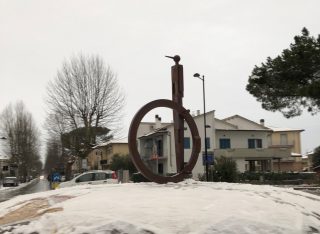
SAINT MINIATO
Our town has the name of a saint, Saint Minias (Minas, Miniatus)( Italian: Miniato), who is venerated as the first Cristian martyr in Florence.
According to a legend, Minias was an Armenian king or prince serving in the Roman Army or going on a pilgrimage to Rome.
He became a hermit near Florence and Emperor Decius, who was persecuting the Christians, wanted him to become pagan.
Minias refused, so he was stoned and thrown to a lion or a panther or a leopard in an amphitheatre, but he survived. Finally, he was beheaded near Piazza della Signoria.
The legend states that he picked up his own head, crossed the River Arno and returned to his hermitage on the hill known as Mons Florentinus.
The name of our town comes from a small church dedicated to Saint Minias, built by a group of Lombards who settled here in 783 A.D.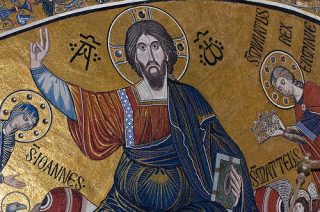 Saint Minias is depicted as a young prince holding a crown, crowned with a rod, palm and a lily, carrying his head.
Saint Minias is depicted as a young prince holding a crown, crowned with a rod, palm and a lily, carrying his head.
The church of San Miniato al Monte in Florence was built on the grave of this Christian martyr.
Sitografia : www.wikipedia.org ; www.slowtuscany. it ; www.googleimmagini.it

